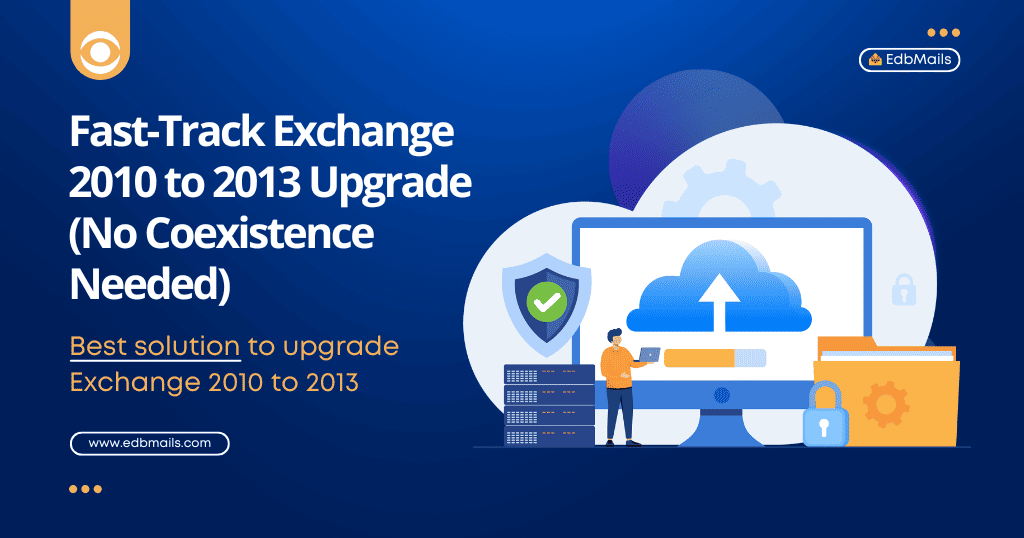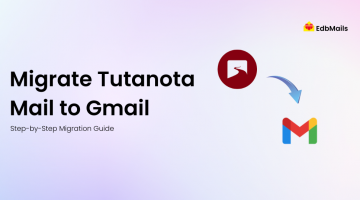Migrating from Microsoft Exchange 2010 to a newer version is more than just a technical upgrade — it’s a business-critical step for ensuring security, compliance, and productivity. Many organizations initially looked to Exchange 2013 as the next step. It offered better performance, modern web access, enhanced scalability, and improved security features compared to Exchange 2010.
However, Exchange Server 2013 reached its end of support in April 2023, which means Microsoft no longer provides security patches, bug fixes, or technical assistance. Running unsupported software exposes businesses to security threats, compliance risks, and system instability.

For this reason, many IT leaders are now bypassing Exchange 2013 and upgrading directly to Exchange 2019 — a stable, long-term solution with modern authentication, higher scalability, and advanced compliance support.
No matter your destination — whether Exchange 2013, 2016, or 2019 — EdbMails Exchange Migration helps you move seamlessly, without coexistence, downtime, or data loss.
Why Avoid Coexistence in Exchange Migration?
Microsoft supports coexistence for gradual migrations, where old and new servers run side by side. However, this approach adds unnecessary complexity:
- Complicated Mail Flow
Running multiple versions simultaneously introduces routing, synchronization, and DNS complexities that increase chances of errors. - Longer Project Timelines
Setting up hybrid servers and maintaining coexistence often delays project completion. - Increased Security Risks
Older, unsupported servers must stay online during coexistence, exposing your organization to vulnerabilities. - Higher Operational Costs
Managing multiple versions of Exchange requires more licenses, hardware, and administrative time.
By contrast, a direct migration eliminates these challenges. With EdbMails, you can upgrade in fewer steps, with lower risk, and without the burden of running multiple environments.
Common Challenges with Native Exchange Migration
Microsoft provides native methods like Cutover, Staged, and Hybrid migrations, but they are often complex and not ideal for modern business requirements. Some limitations include:
- Lengthy Setup & Prerequisites: Requires PowerShell expertise, Active Directory preparation, and multiple validation steps.
- Downtime Risks: Users may lose access during mailbox moves, disrupting productivity.
- Limited Granularity: No option to selectively migrate mailboxes, folders, or items.
- Data Duplication: Without incremental sync, re-runs can cause duplicates or missing items.
- Manual Overhead: Complex mailbox mapping, PST exports, and uploads increase human error.
- Compliance Risks: Native tools lack robust audit logging and governance features.
Businesses today require speed, security, and minimal disruption — areas where EdbMails provides clear advantages.
Best Solution to Upgrade Exchange 2010
If you’re still running Exchange 2010, upgrading is urgent — not just for performance but also for security and compliance. While Exchange 2013 was once a logical step, its end of support makes Exchange 2019 the best long-term option.
With EdbMails Exchange Migration Tool, you can:
- Upgrade Exchange 2010 to 2013 for short-term needs.
- Or move directly to Exchange 2019 for a future-proof, stable, and supported environment.
Supported Migration Paths :
- Exchange 2010 to Exchange 2013 (legacy compatibility)
- Exchange 2010 to Exchange 2016 (mid-tier upgrade)
- Exchange 2010 to Exchange 2019 (recommended, long-term solution)
What EdbMails Migrates
- User mailboxes with all items (emails, calendars, contacts, notes, tasks, journals).
- Archive mailboxes and shared mailboxes.
- Public folders and permissions.
- Mailbox rules and folder hierarchy.
With EdbMails, your data is preserved exactly as it was, ensuring a smooth end-user experience after migration.
Pre-Migration Checklist
Before starting your Exchange migration project, consider the following preparation steps:
- Update Exchange 2010 – Apply the latest cumulative updates and service packs.
- Verify Active Directory Health – Ensure replication and DNS configurations are working correctly.
- Review Mailbox Sizes – Archive or clean up unnecessary data to optimize migration time.
- Prepare Target Server – Set up Exchange 2013/2016/2019 with required mailbox databases.
- Plan User Communication – Inform users about migration timelines and possible changes.
👉 With EdbMails, many steps such as mailbox auto-mapping, automatic mailbox creation on target server, incremental sync, and connection validation are automated, reducing the manual workload for administrators.
Key Features of EdbMails
EdbMails is more than just a migration tool — it’s an enterprise-grade solution that ensures security, continuity, and compliance:
- Version Flexibility – Migrate directly from Exchange 2010 to 2013, 2016, or 2019.
- Granular Control – Include/exclude specific mailboxes, folders, or items.
- No Downtime – Users continue accessing their mail during migration.
- True Incremental Migration – Transfers only new and modified items in subsequent runs.
- Public Folder & Archive Support – Move all organizational data seamlessly.
- Secure Authentication – OAuth 2.0 modern authentication with Microsoft 365.
- Audit & Compliance – Detailed migration reports aligned with GDPR, HIPAA, ISO 27001.
- Scalable Solution – Supports SMBs, enterprises, and multi-tenant environments.
Benefits of Using EdbMails
When upgrading Exchange 2010, EdbMails offers unmatched advantages compared to native or manual methods:
- Simplified Process: No coexistence, hybrid complexity, or manual PST handling.
- Business Continuity: Zero downtime ensures workflows remain uninterrupted.
- Future-Proof Migration: Directly migrate to Exchange 2019, avoiding unsupported platforms.
- Faster Time-to-Value: Automated setup, auto-mapping, and real-time progress tracking.
- Cost Efficiency: Lower administrative overhead and reduced hardware needs.
- Trusted Solution: Used by thousands of organizations worldwide for secure, large-scale migrations.
How to Perform Exchange 2010 to 2013 Migration with EdbMails
EdbMails simplifies migrations into a few easy steps:
- Download & Install EdbMails Exchange Migration Tool.
- Connect Source – Log in to your Exchange 2010 server
- Connect Target – Log in to your Exchange 2013 server.
- Select Mailboxes – Choose full or selective migration (folders, items, public folders).
- Start Migration – Begin the transfer and monitor live progress in the dashboard.
- Verify & Test – Check mailbox access and functionality on the target Exchange server.
👉 For detailed step-by-step instructions, see the EdbMails Exchange Migration Guide.
Frequently Asked Questions:
1. Can I migrate from Exchange 2010 to 2013 without coexistence?
Yes. EdbMails allows direct migration without coexistence setups or hybrid configurations.
2. What if I want to skip Exchange 2013 and migrate to 2019?
EdbMails fully supports Exchange 2010 to 2019 migrations, which is recommended since Exchange 2013 has reached end of support.
3. Will users experience downtime during migration?
No. EdbMails enables continuous user access, ensuring business continuity.
4. How secure is the migration with EdbMails?
Security is a top priority during any Exchange migration. EdbMails ensures your data remains fully protected throughout the process by using OAuth 2.0 modern authentication for secure logins, AES 256-bit end-to-end encryption for data transfer, and strict compliance with international standards such as GDPR, HIPAA, and ISO 27001.
5. Can I migrate public folders and shared mailboxes?
Yes, EdbMails supports public folder, archive, and shared mailbox migration.
6. Does EdbMails support incremental migration?
Yes. Only new and modified items are transferred in subsequent runs, avoiding duplicates.



